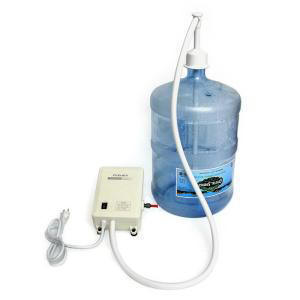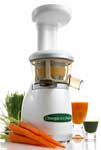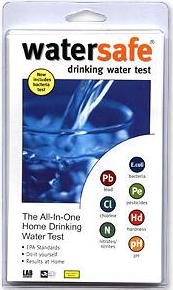|
Watersafe® All-In-One Test
Kit
For city or municipal source water
$19.95
Order Now
What is in
the water that comes out of your tap? Even
if you don’t drink tap water, chances are
you cook, bathe and brush your teeth with
it, and could be allowing contaminants into
your system and that of your children.
Until now accurate testing for contaminants
was only available through expensive,
analytical laboratories using complicated
and time-consuming methods.
This do-it-yourself test
kit allows you to check your drinking water
for eight common contaminants.
The Watersafe® All-In-One is
fast, accurate, easy to use, and produce
results on the spot.
Chronic
exposure to chemical contaminants are
particularly dangerous and these toxins are
highly insidious, causing damage over months
and years, often with serious or deadly
effects. Water contaminants can be man-made
or naturally occurring.
The
Watersafe® All-In-One can be used to
test for the following
eight
contaminants :
Bacteria
contaminated water may not smell or
taste bad. Bacteria in drinking water
contaminated by human waste has been
linked to illnesses such as typhoid,
dysentery, cholera, and hepatitis. When
an area is flooded due to persistent
rains, the sewage treatment systems can
get overwhelmed and contaminate the
drinking water supply. To
learn more and read the [Bacteria
Test Instructions]
Lead
which causes a wide
variety of developmental , neurological
and kidney problems can be found in
water.
Some city water
treatment facilities have lead in
valves, gaskets, distribution mains and
service lines. As you might expect some
older homes have original lead plumbing,
but surprisingly, many new homes also
pose a risk, as excessive leaching from
leaded solder and brass fixtures, such
as faucets, can happen for the first
year. [Lead
Test Instructions]
Pesticides
have been discovered in every large
watershed in the US and in a large
percentage of groundwater wells and have
been l inked
to increased cancer rates. To learn more
and read the [Pesticide
Test Instructions]
Nitrates/Nitrites although low
levels of nitrates may occur naturally
in water, sometimes higher levels, which
are potentially dangerous to infants,
are found in water. Nitrates may cause
methemologlobinemi, a condition known as
“blue baby” and other developmental
problems. In 1992, when the survey was
released, some 22,500 infants drinking
domestic well water were estimated to be
exposed to levels of nitrates exceeding
the EPA safe drinking water limits; for
community systems, the number was
estimated to be 43,500 infants.
Sources of nitrogen and nitrates may
include runoff or seepage from
fertilized agricultural lands, municipal
and industrial waste water, refuse
dumps, animal feedlots, septic tanks and
private sewage disposal systems, urban
drainage and decaying plant debris.
Geologic formations and direction of
ground water flow also may influence
nitrate concentration.
Chlorine,
used for disinfection, can react with
organic matter to form cancer-causing
trihalomethanes.
By-products can increase cancer risk;
bad taste and smell. You can read more
about the
Dangers of
Chlorine.
pH-
Knowing the pH level of your water
can help you prevent secondary effects
- If the acidity of your water is too
high, corrosion can leach out lead from
pipes and plumbing as well as damage
your water supply system and water
heater.
Hardness. Hard water is not a
health hazard; in fact hard water is an
excellent source of dietary calcium and
magnesium. The problem with hard water
is that lime scale builds up in pipes
causing corrosion, reduce the efficiency
of hot water heaters, increase water
consumption when taking a bath (to
remove soap), leave spotting and filming
on dishes/cookware.
If you have water hardness problems
visit our
Magnetizer Hard Water Conditioner
page for the best solution to water
hardness problems.
[Testing
Kit Page]
Watersafe®
Bacteria Test Kit Instructions
Check for the presence of bacteria in
your drinking water with this do-it-yourself, EPA-based
test kit. This tests for the presence of Coliform
Bacteria in your water. The presence of bacteria
in drinking water is usually a result of a problem with
the water treatment system or the pipes which distribute
water, and indicates that water may be contaminated with
germs that can cause disease as stated above.
General Instructions:
-
Keep tests out of
reach of children or pets.
-
Do not ingest anything from this test kit.
-
Do not drink water sample used for testing.
-
Store and use at room temperature (60-86 F).
-
Do not use on hot water or water containing bleach detergents.
-
Do not re-use any part of the test kit.
-
Do not open
packets or vial until you are ready to perform the
tests.
-
Read and follow all instructions
carefully.
Bacteria Test Instructions:
-
Take out
the Bacteria Test vial and set upright on a flat
surface.
-
Collect water sample or turn on tap to a
very slow stream.
-
Carefully twist off cap and
fill vial to 1/2 inch below the top (to 5 ml line).
-
DO NOT OVERFILL and DO NOT SPILL the bacterial
growth powder in the vial.
-
Replace cap and twist
on tightly. Shake the vial vigorously for 20
seconds.
-
Place the capped vial upright in a warm
area (70-90 F) where it cannot be disturbed for 48
hrs.
-
After 48 hrs.,
observe the color of the liquid without opening the
vial:
|
Purple color:
Negative Result |
Yellow Color:
Positive Result |
|
 |
 |
|
(No bacteria were detected) |
(It is
highly likely that potentially harmful bacteria were
detected). |
For positive
results, add bleach to the sample before pouring down
the toilet, then wash hands carefully. Negative samples
may be poured directly into the toilet. Discard vial in
the trash.
Note: If your water tests outside the desired values,
call 888.438.1942. Also, please note that
Watersafe® is a screening test and can
not be used to certify water as safe or unsafe for
drinking.
Watersafe®
provides approximate results ONLY
when used in strict accordance with instructions. We
expressly disclaims any liability resulting from the
use of this product, failure to follow instructions,
or reliance of test results.
Water safe®
Lead Test Kit Instructions
The Watersafe® Lead Test
can detect dissolved lead at levels below the EPA Action
level of 15 parts per billion (ppb). Folks this is one
test you should have. In the US about 1,000,000 children under the age of
six have a blood lead level exceeding the level of
concern.
Just take 10 minutes to protect
your family from the damaging effects of
lead.
Lead Test
Instructions
1.
Open Lead packet and take out
all contents. The packet contains a test vial, a
dropper pipette, two Watersafe®
Test Strips, and a desiccant (to be discarded).
2. Using dropper, place exactly
TWO
dropper-fuls of water sample into test
vial. To pick up the sample, tightly squeeze the
bulb at the end of the dropper and place the
open end into the water sample. Release the bulb
to pick up the sample, then squeeze again to
expel the sample into the vial.
3.
Swirl vial gently for several seconds. Place on
a flat surface.
4.
Place both test strips into the test vial, with
arrows pointing DOWN.
5.
Wait 10 minutes. Do not disturb strips or vial
during this time. Blue lines will appear on the
strips.
6.
Take the strips out of the vial and lay them on
a flat surface with the arrows pointing to the
LEFT.
Interpreting The Results
Negative
The LEFT line (next to number 1) is darker than the
RIGHT line (next to number 2)

If you only see the LEFT line (next to number 1), the
test is negative)
Positive: The RIGHT line (next
to number 2) is darker than the LEFT line (next to
number 1), or lines are equally dark (Both LEFT and
RIGHT lines are equally dark)

7.
Note: If no lines appear, or both lines are very
light, the test did not run properly and the
result is not valid. If a test strip
shows a positive result, your water sample may
contain lead or pesticides at a toxic level.

Watersafe®
Pesticide Test Kit Instructions
The Watersafe Pesticide test
kit is a one step test kit that detects two
of the most common pesticides (Atrazine - 3
ppb and Simazine - 4 ppb) used in the United States at
the EPA maximum contaminant level. Results
in 10 minutes. If you car concerned about
pesticides on your produce, then you should
be also concerned about pesticides in your
drinking water? Now you can test your water
for harmful pesticide contamination-safely
and accurately.
Before you begin...
-
Keep
tests out of reach of
children and pets.
-
Do not
ingest anything from
this test kit. Do not
drink water sample used
for testing. Store and
use at room temperature
(60-86 F).
-
Do not
open packets or a vial
until you are ready to
perform the tests.
-
Do not
use on hot water or
water containing bleach
detergents.
-
Do not
re-use any part of the
test kit.
-
Read and
follow all instructions
carefully.
Pesticide Test Instructions
-
Open
Pesticide
packet and take out all
contents. The packet
contains a test vial, a
dropper pipette, two
Watersafe® test
strips, and a desiccant
(to be discarded).
-
Using the
dropper, place exactly
TWO
dropper-fuls of
water sample into test
vial. To pick up the
sample, tightly squeeze
the bulb at the end of
the dropper and place
the open end into the
water sample. Release
the bulb to pick up the
sample, then squeeze
again to expel the
sample into the vial.
-
Swirl
vial gently for several
seconds. Place on a flat
surface.
-
Place
both test strips into
the test vial, with
arrows pointing DOWN
-
Wait 10
minutes. Do not disturb
strips or vial during
this time. Blue lines
will appear on the
strips.
-
Take the
strips out of the vial
and lay them on a flat
surface with the arrows
pointing to the LEFT.
Interpreting The Results:
Negative
If the LEFT line (next to number 1) is darker than the
RIGHT line (next to number 2) or if you only see the LEFT line (next to number 1), the
test is negative)

Positive: If ihe RIGHT line (next
to number 2) is darker than the LEFT line (next to
number 1), or if lines are equally dark (Both LEFT and
RIGHT lines are equally dark)

7.
Note: If no lines appear, or both lines are very
light, the test did not run properly and the
result is not valid. If a test strip
shows a positive result, your water sample may
contain lead or pesticides at a toxic level.
Water safe
pH/Hardness/Chlorine Kit Instructions
If levels of chlorine,
hardness or pH are too
high, your water could
be damaging your
plumbing, your
pocketbook, and your
health. pH -
If the acidity of your
water is too high,
corrosion can leach out
lead from pipes and
damage your water supply
system and water heater.
Hardness -
lime scale builds up in
pipes causing corrosion,
reduce the efficiency of
hot water heaters, and
require more water to
remove soap.
Chlorine
-
can increase cancer risk;
bad taste and smell.
pH/Hardness/Chlorine
Test Instructions
1. Carefully
open pH/Hardness/Chlorine Test packet and take
out test strip.
2. Immerse the reagent pads into the water
sample and remove immediately. Hold the strip
level for 15 seconds.
3. Match pH, Hardness and Total Chlorine Pads
(in that order) to the color chart below.
pH (end pad)

Total Chlorine (pad nearest
handle)

LR Total Hardness (middle pad)

Return to Testing Kit Page
pHion pH
Test Stix |
Chlorine Test Kit |
Fluoride/Chlorine Test Kit
WaterSafe All-In-One Test Kit |
Alkaline Water Test Kit |
Heavy Metal Test Kit
Hanna ORP
Test Meter |
Hanna ORP/Temp/pH Test Meter
Product Categories:
Far Infrared |
Exercise
|
Sleep Aid
| Water
Filtration
|
Air Filtration
| Test Kits
|
Supplements
|
Health
Books
| EMF
Protection |
Juicers
|
Skin Care
|
Emergency Products
Internet
Partners
Home |
Privacy Policy |
Return
Policy |
Disclaimer
|
Contact Us
Copyright 2011-2013, MicroWaterWoman.com, All Rights Reserved
|


































 Reduce Electric Bill & EMF Pollution
Reduce Electric Bill & EMF Pollution


















